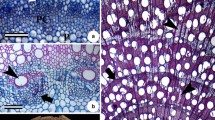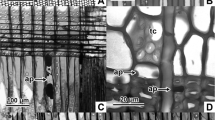Summary
Three different patterns of differentiation were respectively characteristic of the three types of xylem parenchyma found in trembling aspen: Non-vessel-associated ray parenchyma cells formed lignified secondary walls and, generally, a lignified isotropic layer, within one growing season; axial parenchyma cells formed thickened primary walls at the end of the growing season but did not lignify, nor form secondary walls and an isotropic layer, until the following growing season; vessel-associated ray cells (contact cells) formed a lignified, outer secondary wall and an unlignified protective layer during the first growing season but did not differentiate further until heartwood formation when, following tylosis formation, lignification of the protective layer and newly developed inner secondary wall layers occurred.
Multivesicular bodies, which derived from large Golgi vesicles and developed through small invaginations of the membrane, were associated with cell wall formation and were abundant during protective layer development. The protective layer first formed along the vessel-adjacent, secondary wall thickenings of the contact cell before death of the vessel protoplast, and subsequently formed along the pit membrane and on the opposite cell wall. The development of tylosis “initials”,i.e., the protruding, contact cell pit membranes, lined internally by protective layers, was recorded and it was observed that the formation of these protuberances and the death of the vessel protoplast did not precisely coincide.
As the evidence did not support the previous contention that the protective layer formed in response to the death of the vessel, and since information published elsewhere has revealed that contact cells are involved in metabolically mediated sugar secretion into vessels, a possible involvement in intercellular transport was considered for this layer. In this connection, the protective layer was also discussed with respect to wall structure found in “transfer cells”.
Similar content being viewed by others
References
Albersheim, P., K. Mühlethaler, andA. Frey-Wyssling, 1961: Stained pectin as seen in the electron microscope. J. biophys. biochem. Cytol.8, 501–506.
Barton, R., 1968: Autoradiographic studies on wall formation inChara. Planta (Berl.)82, 302–306.
Bland, D. E., R. C. Foster, andA. F. Logan, 1971: The mechanism of permanganate and osmium tetroxide fixation and distribution of lignin in the cell wall ofPinus radiata. Holzforschung25, 137–143.
Braun, H. J., 1967: Entwicklung und Bau der Holzstrahlen unter dem Aspekt der Kontakt-Isolations-Differenzierung gegenüber dem Hydrosystem. I. Das Prinzip der Kontakt-Isolations-Differenzierung. Holzforschung21, 33–37.
Chafe, S. C., and G.Chauret, 1974: Cell wall structure in the xylem parenchyma of trembling aspen. Protoplasma (in press).
—, andD. J. Durzan, 1973: Tannin inclusions in cell suspension cultures of white spruce [Picea glauca (Moench) Voss]. Planta (Berl.)113, 251–262.
—, andWardrop, 1970: Microfibrillar orientation in plant cell walls. Planta (Berl.)92, 13–24.
Cox, G. C., andB. E. Juniper, 1973: Autoradiographic evidence for paramural-body function. Nature New Biol.243, 116–117.
Cronshaw, J., 1965: Cytoplasmic fine structure and cell wall development in differentiating xylem elements. In: Cellular ultrastructure of woody plants, pp. 99–124 (W. A. Cote, Jr., ed.). Syracuse: Syracuse Univ. Press.
Cunningham, W. D., D. J. Morre, andH. H. Mollenhauer, 1966: Structure of isolated plant Golgi apparatus revealed by negative staining. J. Cell Biol.28, 169–179.
Czaninski, Yvette, 1973: Observations sur une nouvelle couche parietale dans les cellules associees aux vaisseaux du Robinier et du Sycomore. Protoplasma77, 211–219.
Durzan, D. J., S. C. Chafe, andS. M. Lopushanski, 1973: Effect of environmental changes on sugars, tannins, and organized growth in cell suspension cultures ofPicea glauca (Moench) Voss. Planta (Berl.)113, 241–249.
Esau, K., V. I. Cheadle, andR. H. Gill, 1966: Cytology of differentiating tracheary elements. II. Structures associated with cell surfaces. Amer. J. Bot.53, 765–771.
Foster, R. C., 1964: Fine structure of tyloses. Nature204, 494–495.
—, 1967: Fine structure of tyloses in three species of theMyrtaceae. Aust. J. Bot.15, 25–34.
Fowke, L. C., andG. Setterfield, 1969: Multivesicular structures and cell wall growth. Canad. J. Bot.47, 1873–1877.
Griffiths, D. A., 1970: Paramural bodies in hyphae ofVerticillium dahlae Kleb. revealed by freeze-etching. Arch. Mikrobiol.73, 331–336.
Gunning, B. E. S., andJ. S. Pate, 1969: “Transfer cells”. Plant cells with wall ingrowths, specialized in relation to short distance transport of solutes — their occurrence, structure, and development. Protoplasma68, 107–133.
— —, andL. G. Briarty, 1968: Specialized “transfer cells” in minor veins of leaves and their possible significance in phloem translocation. J. Cell Biol.37, C 7-C 12.
— —, andL. W. Green, 1970: Transfer cells in the vascular system of stems: Taxonomy, association with nodes, and structure. Protoplasma71, 147–171.
Halperin, W., andW. A. Jensen, 1967: Ultrastructural changes during growth and embryogenesis in carrot cell culture. J. Ultrastruct. Res.18, 428–443.
Hepler, P. K., D. E. Fosket, andE. H. Newcomb, 1970: Lignification during secondary wall formation inColeus: An electron microscope study. Amer. J. Bot.57, 85–96.
Imagawa, H., andS. Ishida, 1972: Study on the wood formation in trees. Report III. Occurrence of the overwintering cells in cambial zone in several ring-porous trees. Res. Bull. Coll. Exper. For. Hokkaido Univ.29, 207–222.
Jensen, W. A., 1965: The composition and ultrastructure of the nucellus in cotton. J. Ultrastruct. Res.13, 112–128.
Marchant, R., andR. T. Moore, 1973: Lomosomes and plasmalemmasomes in fungi. Protoplasma76, 235–247.
—, andA. W. Robards, 1968: Membrane systems associated with the plasmalemma of plant cells. Ann. Bot.32, 457–471.
Meyer, R. W., 1967: Tyloses development in white oak. For. Prod. J.17, 50–56.
—, andW. A. Cote, Jr., 1968: Formation of the protective layer and its role in tylosis development. Wood Sci. Technol.2, 84–94.
Mia, A. J., 1973: Fine structure of tylosis inPopulus tremuloides. Amer. J. Bot.60, Suppl. No. 4, p. 10.
Mollenhauer, H. H., andD. J. Morre, 1966: Golgi apparatus and plant secretion. A. Rev. Plant Physiol.17, 27–46.
Newcomb, E. H., 1969: Plant microtubules. A. Rev. Plant Physiol.20, 253–288.
O'Brien, T. P., 1970: Further observations on hydrolysis of the cell wall in the xylem. Protoplasma69, 1–14.
—, andK. V. Thimann, 1967: Observations on the fine structure of the oat coleoptile. III. Correlated light and electron microscopy of the vascular tissues. Protoplasma63, 443–478.
Pickett-Heaps, J. D., 1966: Incorporation of radioactivity into wheat xylem walls. Planta71, 1–14.
Pojnar, E., J. H. Willison, andE. C. Cocking, 1967: Cell-wall regeneration by isolated tomato-fruit protoplasts. Protoplasma64, 460–480.
Reeve, R. M., 1958: A specific hydroxylamine-ferric chloride reaction for histochemical localization of pectin. Stain Technol.34, 209–211.
Robards, A. W., 1968: On the ultrastructure of differentiating secondary xylem in willow. Protoplasma65, 449–464.
Sauter, J. J., 1972: Respiratory and phosphatase activities in contact cells of wood rays and their possible role in sugar secretion. Z. Pflanzenphysiol.67, 135–145.
Sauter, J. J., W. Iten, andM. H. Zimmermann, 1973: Studies on the release of sugar into the vessels of sugar maple (Acer saccharum). Canad. J. Bot.51, 1–8.
Schmid, Roswitha, 1965: The fine structure of pits in hardwoods. In: Cellular ultrastructure of woody plants, pp. 291–304 (W. A. Cote, Jr., ed.). Syracuse: Syracuse Univ. Press.
Spurr, A. R., 1969: A low-viscosity epoxy resin embedding medium for electron microscopy. J. Ultrastruct. Res.26, 31–43.
Walker, W. S., andT. Bisalputra, 1967: The fine structure of vesicles associated with the cell surface inHelianthus shoot tissue. Canad. J. Bot.45, 2103–2108.
Author information
Authors and Affiliations
Rights and permissions
About this article
Cite this article
Chafe, S.C. Cell wall formation and “protective layer” development in the xylem parenchyma of trembling aspen. Protoplasma 80, 335–354 (1974). https://doi.org/10.1007/BF01276350
Received:
Issue Date:
DOI: https://doi.org/10.1007/BF01276350




